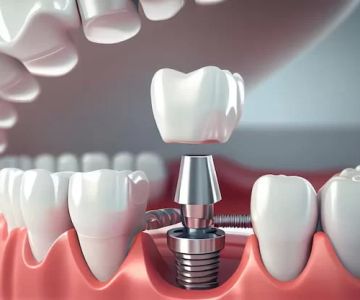Mouth Ulcers vs. Oral Cancer: How to Differentiate and Recognize Key Signs
- 1. Understanding Mouth Ulcers
- 2. Understanding Oral Cancer
- 3. How to Differentiate Mouth Ulcers from Oral Cancer
- 4. When to See a Dentist
- 5. Real Stories and Experiences
1. Understanding Mouth Ulcers
Mouth ulcers, also known as canker sores, are small, painful sores that develop inside the mouth, often on the cheeks, gums, or tongue. They are common and usually not a cause for concern. Most mouth ulcers heal on their own within one to two weeks, though they can be uncomfortable and irritating.
These ulcers can be triggered by various factors, including stress, minor mouth injuries, certain foods, or hormonal changes. In some cases, mouth ulcers may also be a sign of an underlying health condition, but they are typically not a sign of something more serious.
2. Understanding Oral Cancer
Oral cancer, on the other hand, refers to malignant growths that develop in the mouth, tongue, or throat. It is a much more serious condition that can lead to life-threatening consequences if not caught early. Oral cancer can present in various forms, such as persistent sores, lumps, or unusual growths in the mouth that do not heal.
Common risk factors for oral cancer include smoking, excessive alcohol use, human papillomavirus (HPV) infection, and a history of oral cancer in the family. Unlike mouth ulcers, oral cancer may not heal on its own and typically requires medical intervention, including surgery, radiation, or chemotherapy, depending on the stage of the cancer.
3. How to Differentiate Mouth Ulcers from Oral Cancer
It can be challenging to tell the difference between mouth ulcers and oral cancer, as they can sometimes share similar symptoms. However, there are some key differences that can help you distinguish between the two:
- Duration: Mouth ulcers usually heal within one to two weeks, whereas oral cancer lesions persist and do not heal on their own. If a sore in your mouth lasts longer than two weeks, it could be a sign of oral cancer.
- Appearance: Mouth ulcers typically appear as small, round, or oval lesions with a white or yellow center and a red border. In contrast, oral cancer can manifest as sores with irregular borders, lumps, or patches that are raised or hard.
- Location: While mouth ulcers can appear anywhere in the mouth, oral cancer often affects areas such as the tongue, the roof of the mouth, and the floor of the mouth, or the back of the throat.
- Accompanying Symptoms: Oral cancer can be accompanied by symptoms such as persistent pain, difficulty swallowing, a sore throat that doesn't go away, numbness in the mouth, and unexplained weight loss. Mouth ulcers, on the other hand, typically do not cause these additional symptoms.
If you notice any of the more concerning symptoms associated with oral cancer, it is essential to consult a healthcare provider for an evaluation and proper diagnosis.
4. When to See a Dentist
If you're unsure whether your mouth sore is an ulcer or a potential sign of oral cancer, it’s always a good idea to consult a dentist or healthcare provider. Here are some signs that warrant a visit:
- If the sore lasts for more than two weeks.
- If the sore is unusually large or deep.
- If you experience difficulty eating, swallowing, or speaking due to the sore.
- If you notice any lumps, white or red patches, or persistent pain in the mouth.
Your dentist can help determine whether your symptoms are related to a simple mouth ulcer or something more serious, and recommend the appropriate treatment or further investigation.
5. Real Stories and Experiences
Many people have experienced both mouth ulcers and oral cancer, often confused by the symptoms. Here are a couple of stories that illustrate how people differentiate between the two:
- John's Experience: "I had a sore in my mouth that didn’t go away for weeks. It was painful, and I was worried it could be oral cancer. After seeing my dentist, I found out it was just a persistent mouth ulcer, but it was a relief to have it checked out."
- Emma's Story: "I noticed a lump on the roof of my mouth, and it didn’t heal for months. My dentist recommended I get a biopsy, and thankfully, it wasn’t cancer. But it did give me peace of mind to get the proper diagnosis."
These real stories show how important it is to differentiate between mouth ulcers and oral cancer and to seek professional guidance if you're uncertain about your symptoms.
If you're experiencing any oral health concerns, don’t wait. Visit Dentistry Toothtruth to learn more about mouth ulcers, oral cancer, and how to maintain optimal oral health.







 Sundance Endodontics5.0 (254 review)
Sundance Endodontics5.0 (254 review) Dr. Enrique Wismann0.0 (0 review)
Dr. Enrique Wismann0.0 (0 review) Summit View Dentistry PC5.0 (70 review)
Summit View Dentistry PC5.0 (70 review) Pediatric Dental Specialists of Montrose4.0 (169 review)
Pediatric Dental Specialists of Montrose4.0 (169 review) Amir Sobhi, DMD5.0 (1 review)
Amir Sobhi, DMD5.0 (1 review) Dr. Nicole Mackie Dental Implant Specialty Center5.0 (89 review)
Dr. Nicole Mackie Dental Implant Specialty Center5.0 (89 review) The Importance of Oral Health Education During Pregnancy for a Healthy Pregnancy
The Importance of Oral Health Education During Pregnancy for a Healthy Pregnancy Best Tips for Brushing Your Teeth Properly for Healthy Gums: Essential Techniques for Oral Health
Best Tips for Brushing Your Teeth Properly for Healthy Gums: Essential Techniques for Oral Health Why Skipping Dental Checkups Can Lead to Bigger Oral Health Problems
Why Skipping Dental Checkups Can Lead to Bigger Oral Health Problems Advantages of Porcelain Dental Restorations
Advantages of Porcelain Dental Restorations How Can Diabetes Cause Tooth and Gum Problems? Preventing and Managing Oral Health Issues
How Can Diabetes Cause Tooth and Gum Problems? Preventing and Managing Oral Health Issues Healthy Habits for Promoting Good Oral Health and Hygiene: Tips for a Healthy Smile
Healthy Habits for Promoting Good Oral Health and Hygiene: Tips for a Healthy Smile